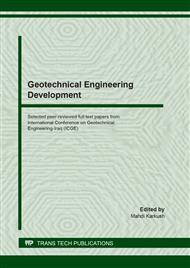p.221
p.228
p.234
p.243
p.253
p.259
p.266
p.273
p.283
Effect of Slag on Engineering Properties of Contaminated Soil
Abstract:
In this study investigates utilizing of slag as an additional material to improve engineering properties of contaminated soil by crude oil to changing the engineering characteristics to be satisfying and compatible, this is due to its pozzolanic reactivity. The aim of this study the impact of slag material in geotechnical engineering and to stabilize properties of contaminated soils. Two percentages of slag were utilized in this study, which is 0% and 6%. Compaction and direct shear strength tests had been conducted on the artificial contaminated prepared soil samples. In the results, showed that the increasing of slag leads to a decrease in the optimum water contents while the maximum dry density values increase. Furthermore, the shear strength is improved by utilizing slag so that slag can be considered as a stabilizing material to improve the properties of contamination soil.
Info:
Periodical:
Pages:
253-258
Citation:
Online since:
August 2020
Authors:
Keywords:
Price:
Сopyright:
© 2020 Trans Tech Publications Ltd. All Rights Reserved
Share:
Citation:


